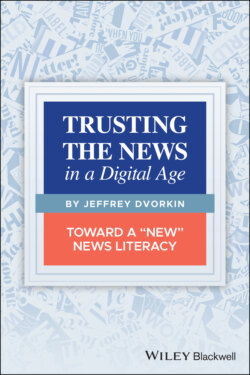Читать книгу Trusting the News in a Digital Age - Jeffrey Dvorkin - Страница 25
The Rise of Digital Technology and Bias
ОглавлениеIt is difficult, if not impossible, for the news‐consuming public to agree on what constitutes reliable information. That is because, in part, the news is a human endeavor and always subject to perceived imperfections and criticism. When the news was provided by fewer sources in the form of newspapers or broadcasters, allegations of bias were always part of the news landscape. But in a digital environment, where information and the responses to that information have increased, so too have accusations of bias. Journalism is not without its flaws, and reliable news organizations have had to adapt to a more raucous and rancorous environment.
Journalists are often surprised when their critics accuse them of bias. Most journalists try to give the audiences their best version of the truth, so accusations of bias are frequently rejected as a form of anti‐media bias itself.
Bias exists, of course. Sometimes it is explicit; sometimes it is subconscious. Because journalism is a human endeavor like any other, some bias is always there. The question we must ask is whether the bias is deliberate or not. If it is deliberate, why is it there and who might benefit from it? If it is subconscious, is it because of other more subtle influences on the journalists or on their media organization? And how deep does it go – is it an unconscious cultural bias or a deliberate, willful blindness?
In a democracy, the signs of news bias are often too subtle to be obvious. We may overlook these indications of bias because we may have internalized them ourselves. We might even personally share these assumptions about the way things are or ought to be. Our own biases tend to direct us toward sources of information that confirm our own points of view. That's not always a bad thing, although it can be if we remain unaware of this in ourselves. But it is more common than we think. In our quest for news literacy, we need to be aware of how our own biases and even prejudices affect our thinking.
In the digital news environment, the public has many more opportunities to select what it feels is important or distracting, depending on the individual needs of the moment. The Internet gives the public the means to comment on the news in a way that was previously more limited to writing a letter to the editor of a newspaper. Today, the flow of commentary inside and outside of news organizations continues unabated. This can be a better way for citizens to let their concerns be seen and heard.
The news is seen as a way of assuring the public that issues are being addressed so citizens can make informed decisions about personal safety. It allows for a greater sense of security and community. And it can also be a way of holding authorities and institutions to account.
The downside of this flow of continuously aggravating information is a sense of perpetual, public grievance in which the Internet can act as an accelerant, raising both tensions and unrealistic expectations. Selecting less serious content as a break from the constant flow of grim news is also now valued by consumers and producers of news.
